Valery Oisteanu: Illegal Mail Art (a poetical essay)
Oisteanu, Valery: Illegal Mail Art (a poetical essay), in: Mail Art Then and Now, The Flue, Vol. 4, No. 3-4 (special issue), Franklin Furnace Inc., New York, USA, 1984 Winter, pp. 11-13.
Growing up behind the iron curtain makes even the most elementary letter a tool of subversion. Correspondence with Westerners is tightly censored and controlled. The letters have a lengthy two week delay to allow snooping KGB gents to x-ray, xerox and translate all mail. The only way to communicate with the outside world of freedom is to code everything. The art of metaphorizing, coding and visual messages became a tool of a new form of communication. Thus mail-art became an instrument of freedom, and the perfection of dadadaist metaphors and the sophistication of conceptual messages. The mail artist will try the impossible by taking the letter to the heights of subversive art. One of my first creations was collective poems or "exquisite corpse" (from the surrealist tradition) through a collaboration of 40 artists from the Eastern European countries. Several letters reached West Berlin and there they were reassembled line by line by my late friend, photographer Martin Roth, and Andrai Eyestone who came to the rescue in the late 1960's to Bucharest, Romania. After years of planning and three unsuccessful attempts, I finally escaped to Rome, thanks to mail-art. During the late 1960's mail-art contained illegal visa rubber stamps, false official stamps, and even fake passports page by page.
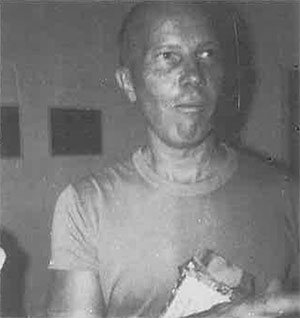
RAY JOHNSON DEVOURING MAIL ART. 1979. Photo by Valery Oisteanu.
When I reached New York in the early 1970's and met Ray Johnson at a "Paloma Picasso-fan club" meeting, only then did mail-art regain its innocence. Ray introduced me to a vast network of ex-New York correspondance school members. In a very short time the underground organization PASS (Poets and Artists Surreal Society), flourished into an international membership club, that established the new link between the mail artists from Russia and Eastern Europe, and the exotic regions of India, Japan, Australia, and New Zealand. (Ed. note: On April 5, 1972 Ray sent a letter announcing the death of NYCS to the New York Times.)

MAY WILSON IN HER STUDIO IN CHELSEA. Photo by courtesy Valery Gallery.
Although Ray Johnson proclaimed NYCS dead, by burning huge trashbags of mail-art, in Locust Valley, the art and the desire were very much alive. Personally, only in the past ten years, I participated in over 100 mail art shows from the first New York postcard show at NYU, to the rebellious shows in front of MOMA, to the mail art mask show at New Zealand University; from the Last Correspondence Show at CSU in Sacramento to the National Cremation of Mail Art at the University of Wisconsin. But the most outstanding events were still the ones organized by the granddada daddy of collective insanity, Rayjo. His events dated from 1955 - in 1955 he had already 200 people on his mailing list - included Buddha University meetings, Nothing Events, Decca Dance, and culminated with the Mail Art Show at the Whitney Museum of Art. Currently a big retrospective of this genius is being organized at Nassau County Museum.
I was very fortunate to curate some of the memorials dedicated to Art and Artists gathered around Ray Johnson. For example the "Grandma Moses's of the Underground" at the Buecker and Harpsichords in Soho and several "Ray Johnson-fan club" international mail-art shows. All of them were a pretext for a reunion of the Legends· of the Avant Garde headed by octogenarians, dadaists, and surrealists like May Wilson, Lil Picard, Sari Dienes, and Charles Henri Ford, Ed Plunkett, Ray Johnson and Cavellini. Beside it's historic and aesthetic value mail-art proves also to be revolutionary; the illegal connection with Romania, Yugoslavia, Hungary and Poland continues until today. Unfortunately we must use private and unofficial messengers and sometimes even diplomatic briefcases or black market "mules" to smuggle correspondence art, antique books and underground writings. For example, the show on Dadaism and Surrealism from Romania, presented in 1980 at Franklin Furnace, featured over 100 artifacts and books smuggled out of Romania over a 12 year period simply because the government banned these books and was holding them under lock and key. With the help of courageous mail artists: "1906-manifestos" written by Tristan Tzara arrived in this country. Valuable drawings by Marcel Janco, Brancusi, and Victor Brauner were shown for the first time ever thanks to anonymous heroes. Thus mail art becomes a force of defiance, resistance, and experimentation. The most common technique to cover the trail of a secret mail art message is remailing it using Ed Plunkett's slogan, "please zen to." The receiver just adds his or her contribution to the message, rubber stamping it, collaging it, and finally reposting it to the next mail connection.
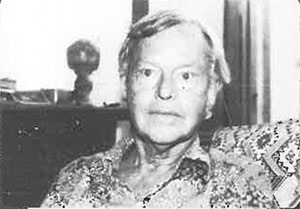
CHARLES HENRI FORD. 1979. Photo-Portrait by Valery Oisteanu.
Another form of testing the freedom of mail is creating unconventional mail objects: AM Fine sends a smashed soda can with a postage stamp attached to it; a Dutch artists sent fake drugs (white powder in a plastic envelope) to his parents; an American rubber stamp reads "report obscene mail to your postmaster"; a Japanese artist uses self made post stamps... all of which defied sanctimonious institutions.
The hardest hit are the art agents, dealers, and the galleries, simply because mail-art evades taxation, percentages, resales, appraisals, and other forms of artist exploitation. Correspondence art is still the freest form of exchange of ideas and collaboration, the most liberal and democratic art trading from artist to artist. Every mail artist is also a lucky and rich collector. And all thanks to Ray Johnson to whom I dedicate this poem manifesto.
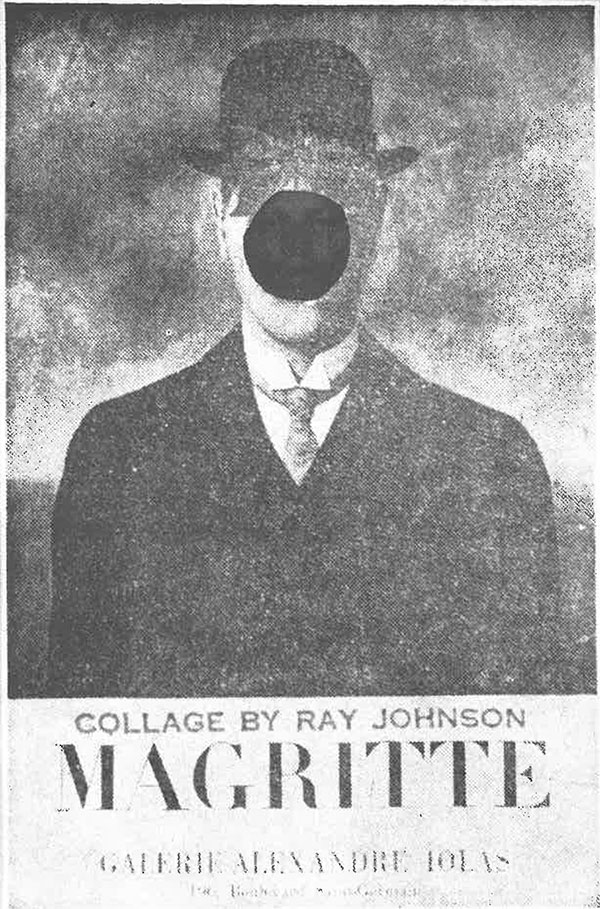
COLLAGE BY RAY JOHNSON. Late 1960s. Ray Johnson, in a direct and droll move,
has superimposed his own features over Magritte's man with a bowler hat.
John Willenbecher collection.
SEND NO ORDINARY LETTERS
Only for Ray Jo
Send snakes of paper combs
and hats
Send May Wilson on glitter stilts
Zen Joseph Cornell - collage - rubbage
And make art silhouette and
Moticos
Correspon-dance of disorganized
scraps
We are the united nations of
trans Avant Garde
Above all galleries and museums
Just shadows pen-pals epistolary
intercourse
A coincidence of probability to
feed Babar
Only for Ray Jo, we sing cha-cha
ump, ump pa pa, Duchamp
Duchamp is a dump, but Ray is
no dead
Just absent, he is asparagus,
spaghetti, blue eyes club
He is a ghost of Kool-Mail-Art
He serenades on his omelet harp
Ruth Ford, Paloma Picasso,
Shelley Duvall, and Yoko Ono
He paints Gertrude Stein with
asbestos lunch
And performs nothing-happenings with pink matches
He drinks pink tea with Kafka
Till it evaporates random like poetry.
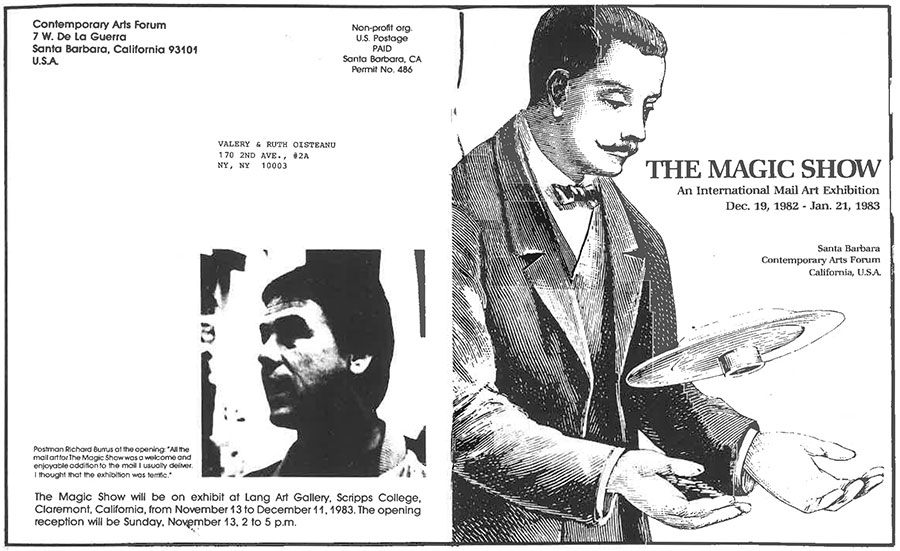
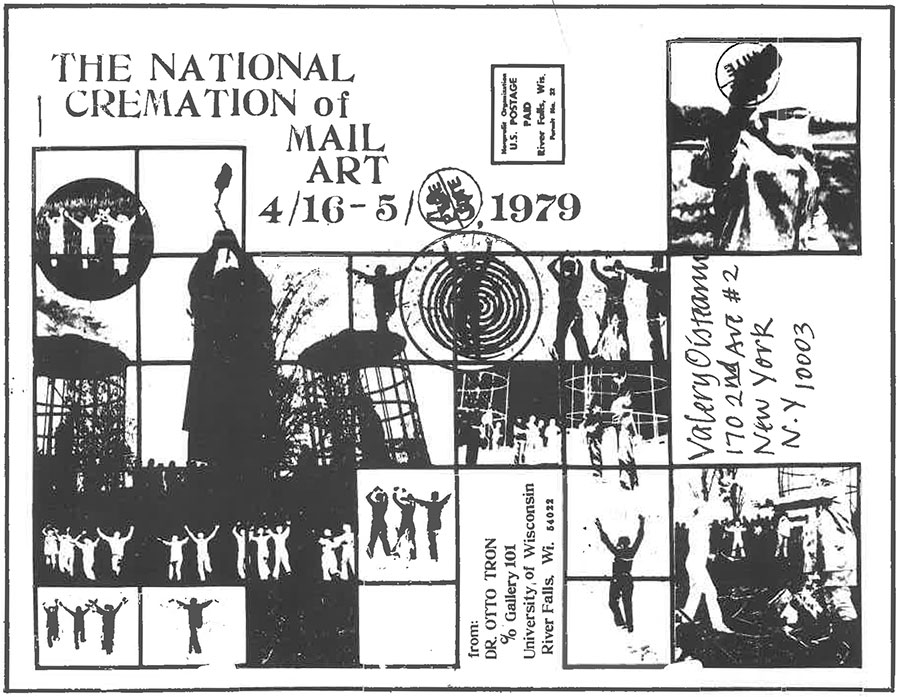
Catalogues of two of the many mail art shows in which Valery Oisteanu has participated.
Valery Oisteanu Collection.
